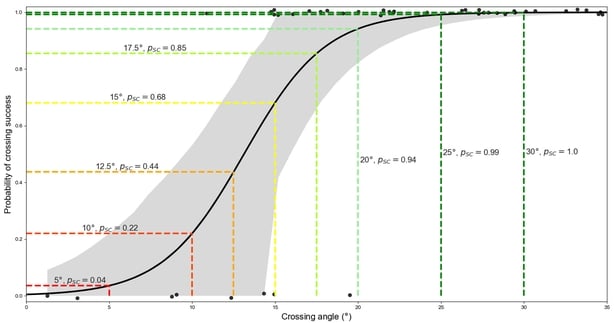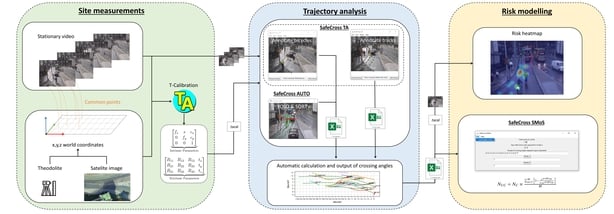Analysis: a video study of cyclists crossing tram tracks in the city has identified various risk levels and contributory factors
By Kevin Gildea, Lund University; Daniel Hall, Clara Mercadal-Baudart, Brian Caulfield and Ciaran Simms, TCD
Cycling in Dublin has witnessed an increase in recent years. As an eco-friendly mode of transport with added health benefits, it's no surprise that many have taken to the streets on two wheels. But with the rise in cycling, there has been a concurrent increase in cyclist injuries, with cyclists accounting for one-fifth of all reported serious injuries since 2016. Moreover, due to underreporting, these figures in fact only represent a small share of the true numbers.
Single bicycle crashes are particularly underestimated, i.e., cases not involving an impact with another road user. While there are numerous contributory factors associated with single bicycle crashes, recent studies involving hospital data and self-reporting have found that tram tracks are a significant contributory factor in Dublin.
We need your consent to load this rte-player contentWe use rte-player to manage extra content that can set cookies on your device and collect data about your activity. Please review their details and accept them to load the content.Manage Preferences
From RTÉ Radio 1's Drivetime, Dr. Damien Ó Tuama from Cyclist.ie and An Taisce on the massive increase in the number of people cycling to work and school
As of 2021, Ireland has embraced a long-term goal to eliminate road traffic deaths and serious injuries by 2050 and Vision Zero now forms the foundation of our Road Safety Strategy. This is a well-established framework for road safety that is based on an ethical philosophy that life and health can never be exchanged for other benefits within society, such as economic growth, transportation efficiency, or technological advancements.
Unlike traditional safety frameworks which often place the responsibility for safety on individuals, and react to the occurrence of injuries, Vision Zero is enacted through a ‘Safe System’ approach. This shifts the majority of responsibility to system designers and policymakers, and takes a proactive stance on collision prevention.
We need your consent to load this rte-player contentWe use rte-player to manage extra content that can set cookies on your device and collect data about your activity. Please review their details and accept them to load the content.Manage Preferences
From RTÉ News, new plan allows more space for Dublin's cyclists and pedestrians
Our study delves into the safety issues associated with cyclist interactions with tram tracks in Dublin city centre using video analysis techniques. Furthermore, in line with Vision Zero, we aimed to develop a proactive safety assessment tool for predicting and preventing potential conflicts.
Traffic camera footage
To gain a clearer picture of the issue, we turned to traffic camera footage from 9 locations around Dublin city centre during October and November 2021. Our focus was on wet road conditions, a known hazard for cyclists. Along with visual assessments, computer vision techniques were used to extract quantitative measures of cyclists’ velocities and crossing angles from the footage.
What we found
During 7 hours of traffic camera footage, 9 unsuccessful crossings were observed (falls or near-falls). One location, Westmoreland St./College St., showed a particularly high risk, so a further 5 hours of footage were surveyed at this location, during which a further 4 unsuccessful crossings were observed. For every 1,000 cyclists at Westmoreland St./College St, about 21 had issues crossing the tracks.
Looking at all locations combined, roughly 3 in every 1,000 cyclists faced issues. Visual assessment of the footage across the city highlighted that most unsuccessful crossings involved obstacles that limited crossing angle, i.e., kerbs or nearby/passing vehicles/other cyclists. Many cases involved passing/nearby vehicles, aligning with international findings that traffic pressure contributes to many falls on tram tracks.

Logistic regression modelling was used to establish the relationships between cyclist velocity, crossing angle and crossing success. As expected, we found that the angle at which a cyclist crosses tram tracks is a strong predictor of whether they'll make it across safely. On the other hand, cyclist velocity didn't have a statistically significant effect. The model allows for estimation of the likelihood of crossing success based on the angle at which a cyclist crosses.
Our study's findings led to the development of SafeCross, an open-source application for proactively assessing risk at locations where cyclists interact with tram tracks. This tool can be used to automatically infer cyclist crossing angles from traffic/roadside cameras and highlight risky sections of the track.

What this means for urban planning
The high overall incidence of unsuccessful crossings observed over this short study period, with limited coverage of the track network, highlights the significance of the safety issues that arise when cyclists interact with tram tracks. Our findings support guidelines from the recently revised Cycle Design Manual, that infrastructural planners should aim for intuitive, self-explainable road layouts that allow for and encourage crossing angles of 60° or more - ideally 90°. However, it is clear from our analysis that cyclists are often forced to cross at shallower angles throughout Dublin, highlighting a clear area for improvement.
The recent draft Dublin City Centre Transport Plan 2023 indicates that we will see a changing cityscape in the coming years. Significant efforts are planned to reduce traffic by 40% and reclaim public space for active and sustainable transport modes. With this, unintended and potentially unforeseeable conflicts are likely to arise.
We need your consent to load this rte-player contentWe use rte-player to manage extra content that can set cookies on your device and collect data about your activity. Please review their details and accept them to load the content.Manage Preferences
From RTÉ News in 2020, Luas operator issues warning about safety around trams
Should design options , even after careful consideration, still present a risk of serious injuries to vulnerable road users, it's important to consider the core principle of 'Vision Zero'. This mandates that the safety of vulnerable road users cannot be compromised, and an expectation of serious injuries cannot be accepted, regardless of considerations relating to cost or transportation efficiency. Urban planning should therefore be approached with a preventative mindset, ensuring safety measures are integrated from the beginning.
But unforeseen safety issues may arise even with the best planning. In such cases, a triage-like approach is necessary, prioritising the most critical areas for targeted interventions. Proactive assessments, such as the one developed in this study, can help in these situations. Our goal is clear: we are building today for a future with zero fatalities or serious injuries.
This article was based on the paper 'Computer vision-based assessment of cyclist-tram track interactions for predictive modelling of crossing success' published in a special issue on cycling safety in the Journal of Safety Research. This content was also presented at the International Cycling Safety Conference (ICSC 2022) in Dresden, Germany, and at the 2023 Cycling & Society Conference in Trinity College Dublin. The authors would like to thank the Road Safety Authority for funding this project through the RSA-Helena Winters scholarship for doctoral studies in road safety and Dublin City Council for providing data and support.
Dr Kevin Gildea is a Research Fellow in the Department of Technology & Society, Faculty of Engineering at Lund University, Sweden. Daniel Hall is a PhD student in the Department of Mechanical, Manufacturing & Biomedical Engineering at TCD, Clara Mercadal-Baudart is a research assistant in the Department of Mechanical, Manufacturing & Biomedical Engineering at TCD. Prof. Ciaran Simms is Professor in Biomechanics and Head of Discipline in the Department of Mechanical, Manufacturing & Biomedical Engineering at TCD. Prof. Brian Caulfield is a Professor in Transportation and Head of Discipline in the Department of Civil, Structural and Environmental Engineering at TCD.
The views expressed here are those of the author and do not represent or reflect the views of RTÉ

